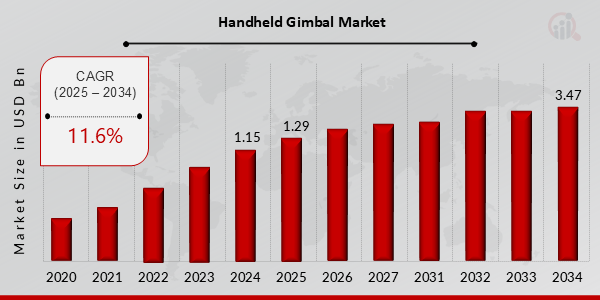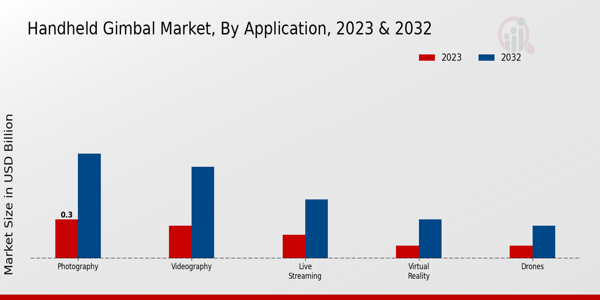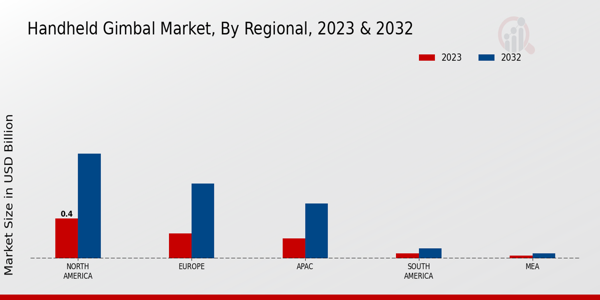Global Handheld Gimbal Market Overview
Handheld Gimbal Market Size was estimated at 1.15 (USD Billion) in 2024. The Handheld Gimbal Market Industry is expected to grow from 1.29 (USD Billion) in 2025 to 3.47 (USD Billion) till 2034, exhibiting a compound annual growth rate (CAGR) of 11.6% during the forecast period (2025 - 2034)
Key Handheld Gimbal Market Trends Highlighted
The Handheld Gimbal Market is significantly driven by the increasing demand for stabilized imaging devices across various sectors such as photography, videography, and content creation. The rise of social media platforms and video-sharing websites has fueled the need for high-quality video content, prompting both amateur and professional creators to seek tools that enhance their production value.
As mobile technology continues to advance, consumers are looking for lightweight, portable stabilization solutions that can easily integrate with smartphones and cameras. Additionally, the growing interest in drone technology, particularly for aerial photography, supports the need for handheld gimbals as complementary devices to achieve smoother shots from multiple angles. There are numerous opportunities to be explored in this market, particularly with the emergence of new applications in live streaming, virtual reality, and augmented reality.
Businesses can capitalize on this trend by developing innovative gimbals that cater to specific user needs, such as those designed for sports enthusiasts or filmmakers who require advanced control features. Furthermore, the untapped potential in developing regions presents a significant opportunity for growth as more individuals and businesses begin to adopt video production for personal or commercial purposes. Recent times have highlighted a trend towards smart technology integration in handheld gimbals, where features such as Bluetooth connectivity, automatic tracking, and built-in antivirus technology are becoming more common.
This shift reflects a broader move towards creating user-friendly devices that simplify the filming process. The market also sees a rising interest in environmentally friendly and durable products, aligning with global conscious consumerism that values sustainability. As the industry continues to evolve, brands must adapt to consumer preferences while exploring innovative solutions to stay competitive.

Source: Primary Research, Secondary Research, MRFR Database and Analyst Review
Handheld Gimbal Market Drivers
Increasing Demand for High-Quality Video Content
The rise of social media platforms and digital content creation has significantly fueled the demand for high-quality video content. In today's digital age, individuals and businesses are continually seeking means to produce engaging and visually captivating videos to capture the attention of online audiences. This trend is not confined to experienced filmmakers or content creators but extends to everyday users who are using smartphones to embark on their video production journeys. As a result, there is a growing need for tools that enhance video quality, reduce shaky footage, and create a professional appearance in recordings.
The Handheld Gimbal Market Industry is at the forefront of addressing this requirement, positioning itself as a vital component for video creators who aspire to elevate their content's production value and storytelling capabilities. Innovations in handheld gimbal technology have made devices lighter, more portable, and equipped with advanced stabilization features, catering to a wide range of users from vloggers to event shooters.
As consumers demand better video quality, the market is likely to continue witnessing a significant growth driven by the proliferation of platforms such as YouTube, Instagram and TikTok. Creators are more inclined to invest in gimbal solutions that allow them to produce smooth panning shots, dynamic angles, and seamless transitions, contributing to a visually captivating piece of content that can stand out in a crowded digital landscape. Bringing in 4K and even 8K video resolutions implies that the requirements for stabilizing technologies should be further raised, resulting in more expansion in the Handheld Gimbal Market Industry.
Rapid Technological Advancements
The Handheld Gimbal Market Industry is seeing remarkable growth driven by rapid advancements in technology. Innovations have ushered in gimbals that boast intelligent features such as automatic balancing, smartphone integration and real-time control through mobile applications. These technological enhancements allow for more efficient and user-friendly operation, appealing to both amateur videographers and seasoned professionals. The incorporation of AI and machine learning functionalities has further refined the stabilization processes and enabled more dynamic filming options.
Growth of Content Creation Ecosystem
The expansion of the content creation ecosystem, which includes platforms for video sharing, education, and marketing, is also fostering the growth of the Handheld Gimbal Market Industry. As brands increasingly recognize the importance of visual storytelling to connect with audiences, there is a greater emphasis on high-quality productions. Consequently, the demand for handheld gimbals has soared as influencers, marketers, and educators seek enhanced tools to produce impactful visuals that resonate with viewers.
Handheld Gimbal Market Segment Insights:
Handheld Gimbal Market Application Insights
The Handheld Gimbal Market is experiencing notable growth with significant revenue contributions across various applications, reflecting a robust demand in the market. The overall market is forecasted to be valued at 0.93 USD Billion in 2023 and is expected to reach 2.5 USD Billion by 2032. Within this context, the applications of handheld gimbals can be broken down into several key areas, namely Photography, Videography, Live Streaming, Virtual Reality and Drones, each showcasing unique growth trajectories and significance in the global market landscape. In terms of market contribution, Photography holds a sizeable share valued at 0.3 USD Billion in 2023, which is projected to rise to 0.8 USD Billion by 2032. This segment's dominance can be attributed to the increasing prevalence of content creation among both amateurs and professionals, making handheld gimbals essential tools for capturing steady and high-quality images under various conditions.
Following closely is the Videography segment, initially valued at 0.25 USD Billion in 2023 and expected to grow to 0.7 USD Billion in 2032, signifying a major interest in video content creation driven by social media and promotional content needs.
Live Streaming has emerged as a significant player in the handheld gimbal market, starting at a valuation of 0.18 USD Billion in 2023 with an anticipated target of 0.45 USD Billion by 2032. The rise of platforms that emphasize real-time content sharing has created a substantial demand for stable video capture, thus elevating the importance of gimbals in streamlining live broadcasts. The Virtual Reality segment is also gaining traction, starting at 0.1 USD Billion in 2023 and projected to reach 0.3 USD Billion by 2032, highlighting the demand for immersive experiences that handheld gimbals help to facilitate. This advancement in technology contributes to enhancing user experience in virtual environments, thus pushing for growth in this arena.
The Drones category, paralleling the demand for aerial photography and videography, is currently valued at 0.1 USD Billion and is expected to progress to 0.25 USD Billion by 2032. The integration of handheld gimbals with drones enables videographers and photographers to achieve stunning aerial shots while maintaining stability and clarity in their footage. Overall, the Handheld Gimbal Market segmentation illustrates a diversified landscape within the Application sector, where each application drives unique demands and showcases growth potential, buoyed by technological advancements and trends in content creation. As such, the market is poised to flourish, propelled by increasing engagement with digital media and the continuous evolution of capturing technologies. The Handheld Gimbal Market data underscores the importance of these applications, positioning them as vital components driving innovation and market expansion.

Source: Primary Research, Secondary Research, MRFR Database and Analyst Review
Handheld Gimbal Market Technological Features Insights
Handheld Gimbal MarketThe market segmentation showcases varying levels of axes, including Less Than 3 Axes, 3 Axes, and More Than 3 Axes configurations. The 3 Axes category is particularly noteworthy as it provides a balance between performance and portability, appealing to both amateur content creators and professional filmmakers alike. Meanwhile, the More Than 3 Axes segment plays a crucial role in fulfilling the demands of high-end cinematography, where complex movements and precision are essential.
On the other hand, the Less Than 3 Axes segment remains relevant due to its cost-effectiveness and simplicity, catering to entry-level users and casual videographers. Overall, these technological features significantly enhance the user experience, contributing to the growth and evolution of the Handheld Gimbal Market. The changing consumer preferences driven by technological advancements further present ample opportunities for this market segment to thrive in the coming years.
Handheld Gimbal Market Distribution Channel Insights
Handheld Gimbal MarketThe distribution channel plays a crucial role in this growth, as it comprises various avenues through which consumers can access gimbal products. Key channels include online retail, retail stores, and distributors. Online retail is becoming increasingly important due to the convenience it offers, allowing customers to easily browse and compare products from the comfort of their homes. Retail stores hold a significant position, providing consumers the chance to physically assess products before purchasing, thus contributing to consumer confidence.
Distributors are vital in ensuring the availability of handheld gimbals across different regions and demographics, facilitating efficient logistics and access to diverse market segments. The overall market growth is driven by the rising demand for stabilizing equipment in the consumer electronics sector and the increasing popularity of content creation. However, challenges such as intense competition and price sensitivity remain. The Handheld Gimbal Market segmentation reveals opportunities for innovation and expansion, particularly in enhancing online presence and optimizing the distribution network.
Handheld Gimbal Market End User Insights
The Handheld Gimbal Market has shown robust growth, particularly within the End User segment, which encompasses Professional, Amateur and Educational users. Professional users are increasingly adopting handheld gimbals for film and media production, enabling them to produce stable and high-quality footage, thus driving a substantial share of the market. Amateur users are also becoming a notable component, spurred by the rise in content creation platforms, where ease of use and portability are critical.In contrast, the educational sector has recognized the importance of handheld gimbals as essential tools for visual storytelling and hands-on learning experiences. The demand across these segments highlights the growth potential of the Handheld Gimbal Market, driven by trends in video production, user-generated content, and emerging applications in educational settings that foster engagement and creativity. Collectively, this segmentation represents a dynamic landscape with varied needs, presenting both opportunities and challenges in the evolving market environment.
Handheld Gimbal Market Regional Insights
The Handheld Gimbal Market revenue reflects a diverse landscape across various regions. In 2023, North America holds a prominent position, valued at 0.4 USD Billion, and is expected to reach 1.05 USD Billion by 2032, showcasing its majority holding within the market. Europe follows with a valuation of 0.25 USD Billion in 2023 and is predicted to rise to 0.75 USD Billion, marking it as a significant player as well. The APAC region, valued at 0.2 USD Billion in 2023, is projected to grow to 0.55 USD Billion, driven by the increasing adoption of advanced filming technologies.
In South America, the market is valued at 0.05 USD Billion in 2023, and it is anticipated to grow to 0.1 USD Billion, albeit at a slower pace. Meanwhile, the MEA region, with a value of 0.03 USD Billion in 2023, is expected to reach 0.05 USD Billion, representing a smaller yet competitive segment within the Handheld Gimbal Market segmentation. The dominance of North America is influenced by the region's vast entertainment industry and technological advancements, underscoring the region's importance in the Handheld Gimbal Market industry.

Source: Primary Research, Secondary Research, MRFR Database and Analyst Review
Handheld Gimbal Market Key Players and Competitive Insights:
The Handheld Gimbal Market is characterized by an ever-evolving landscape of innovation, competition, and technological advancements. The demand for handheld gimbals has surged dramatically, driven by the increasing trend of content creation on platforms like social media and the need for stable video recording in various industries, including filmmaking and vlogging. This competitive market comprises various players, each striving to establish a stronghold by offering unique features, enhanced stability, and user-friendly designs. Understanding the dynamics of this market is crucial for stakeholders looking to capitalize on growth opportunities as consumer preferences shift towards high-quality portable stabilization solutions.
DJI has emerged as a leading player within the Handheld Gimbal Market, owing to its robust portfolio of high-performance stabilization products that cater to both amateur and professional users. The brand is particularly recognized for its innovation, frequently introducing cutting-edge technology that enhances user experience, such as advanced motion sensors and intelligent tracking capabilities. DJI's strong market presence is bolstered by its reputation for delivering quality and reliability, along with an expansive distribution network that ensures accessibility to its products across the globe. Additionally, the company's focus on customer engagement and after-sales support has fostered strong brand loyalty, further solidifying its position as a frontrunner in the handheld gimbal sector.
Zhiyun has also carved out a significant niche in the Handheld Gimbal Market, renowned for its commitment to offering a diverse range of gimbals that appeal to both novice and experienced videographers. The company stands out by prioritizing affordability without compromising on features, which has made its gimbals particularly popular among budget-conscious consumers. Zhiyun's ethos revolves around user-centric design, enabling intuitive operation and versatility in various filming scenarios. Moreover, the company frequently updates its product line with innovative features, such as customizable modes and long battery life, thereby maintaining relevance in a fast-paced market. By continuously adapting to technological trends and user needs, Zhiyun remains a formidable competitor alongside other major players in the handheld gimbal arena.
Key Companies in the Handheld Gimbal Market Include:
- DJI
- Zhiyun
- Gudsen
- FeiyuTech
- Hohem
- CameTV
- Roland
- TARION
- Seculift
- Vivo
- Moza
- EVO Gimbals
- IKAN
- Pilotfly
- Benro
Handheld Gimbal Market Industry Developments
Recent developments in the Handheld Gimbal Market have shown substantial growth and innovation among key players such as DJI, Zhiyun, and Moza. DJI has recently launched advanced models featuring enhanced stabilization technologies, which have been well-received in the consumer electronics space. Zhiyun has expanded its product line, focusing on affordable gimbals for enthusiasts and professionals. Meanwhile, FeiyuTech is reportedly enhancing its collaborations with content creators to promote their latest products, increasing brand awareness.
Current affairs highlight a shift towards more compact, user-friendly designs catering to the rising demand among vloggers and mobile content creators. Additionally, there have been discussions regarding strategic partnerships to enhance distribution channels globally, particularly among brands like Hohem and Gudsen. While no notable mergers or acquisitions have been announced recently within the specified companies, the continued growth in market valuation indicates a robust demand for handheld gimbal solutions. The performance increases and technological advancements of these brands are impacting not only their market positions but also the overall dynamics of the handheld gimbal industry, suggesting a bright future ahead for innovation and competition.
Handheld Gimbal Market Segmentation Insights
Handheld Gimbal Market Application Outlook
- Photography
- Videography
- Live Streaming
- Virtual Reality
- Drones
Handheld Gimbal Market Technological Features Outlook
- Less Than 3 Axes
- 3 Axes
- More Than 3 Axes
Handheld Gimbal Market Distribution Channel Outlook
- Online Retail
- Retail Stores
- Distributors
Handheld Gimbal Market End User Outlook
- Professional
- Amateur
- Educational
Handheld Gimbal Market Regional Outlook
- North America
- Europe
- South America
- Asia Pacific
- Middle East and Africa
|
Report Attribute/Metric
|
Details
|
|
Market Size 2024
|
USD 1.15 Billion
|
|
Market Size 2025
|
USD 1.29 Billion
|
|
Market Size 2034
|
USD 3.47 Billion
|
|
Compound Annual Growth Rate (CAGR)
|
11.6% (2025-2034)
|
|
Base Year
|
2024
|
|
Market Forecast Period
|
2025-2034
|
|
Report Coverage
|
Revenue Forecast, Competitive Landscape, Growth Factors, and Trends
|
|
Market Forecast Units
|
USD Billion
|
|
Key Companies Profiled
|
DJI, Zhiyun, Gudsen, FeiyuTech, Hohem, CameTV, Roland, TARION, Seculift, Vivo, Moza, EVO Gimbals, IKAN, Pilotfly, Benro
|
|
Segments Covered
|
Application, Technological Features, Distribution Channel, End User, Regional
|
|
Key Market Opportunities
|
Increasing demand for content creationRise in smartphone photographyGrowth in travel and adventure sectors Advancements in stabilization technologyExpansion of influencer marketing trends
|
|
Key Market Dynamics
|
Increasing demand for content creationThe rising popularity of mobile filmmaking Growth in social media influence Advancements in stabilization technology, Expansion of travel and adventure vlogging
|
|
Countries Covered
|
North America, Europe, APAC, South America, MEA
|
Frequently Asked Questions (FAQ) :
The Handheld Gimbal Market is projected to reach a valuation of 3.47 USD Billion by 2034.
The market is expected to grow at a CAGR of 11.6% from 2025 to 2034.
North America is projected to dominate the market with an estimated value of 1.05 USD Billion by 2032.
The Videography segment is expected to reach a market value of 0.7 USD Billion by 2032.
Key players in the market include DJI, Zhiyun, Gudsen and FeiyuTech.
The Live Streaming application is anticipated to grow to a market value of 0.45 USD Billion by 2032.
In 2023, the Handheld Gimbal Market was expected to be valued at 0.93 USD Billion.
The Photography segment is projected to grow significantly, reaching a market size of 0.8 USD Billion by 2032.
The Asia Pacific region is expected to achieve a market size of 0.55 USD Billion by 2032.
The drone application is projected to reach a market size of 0.25 USD Billion by 2032.

















